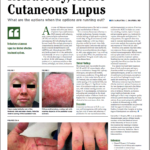With moderate to severe disease, switching to a different anti-TNF, along with treating the symptoms, is recommended.
“[In] switching to another anti-TNF, particularly moving from infliximab to another,” Dr. Merola said, “we’ve had reasonable success, much higher than what was reported in at least some case series.”
For moderate to severe disease that is recalcitrant or worsening, it’s probably best to consider switching to another mechanism of action, based on the patient’s underlying disease state, he said. Patients with IBD, for instance, may be transitioned to ustekinumab, and rheumatoid arthritis patients to abatacept.4 Clinically, he said, many patients present with a variant of plaque disease that has overlapping features with eczema—spongiotic psoriasiform dermatitis on histopathology—as well as pustular variants, including palmo-plantar pustular psoriasis.
Thomas R. Collins is a medical writer based in Florida.
Second Chance
If you missed this session, it’s not too late. Catch it on SessionSelect.
References
- Merola JF, Prystowsky SD, Iversen C, et al. Association of discoid lupus erythematosus with other clinical manifestations among patients with systemic lupus erythematosus. J Am Acad Dermatol. 2013 Jul;69(1):19–24.
- Hornung T, Janzen V, Heidgen FJ, et al. Remission of recalcitrant dermatomyositis treated with ruxolitinib. N Engl J Med. 2014 Dec 25;371(26):2537–2538.
- Afzali A, Wheat CL, Hu JK, et al. The association of psoriasiform rash with anti-tumor necrosis factor (anti-TNF) therapy in inflammatory bowel disease: A single academic center case series. J Crohns Colitis. 2014 Jun;8(6):480–488.
- Sandborn WJ, Gasink C, Gao LL, et al. Ustekinumab induction and maintenance therapy in refractory Crohn’s disease. N Engl J Med. 2012 Oct 18;367(16):1519–1528.

